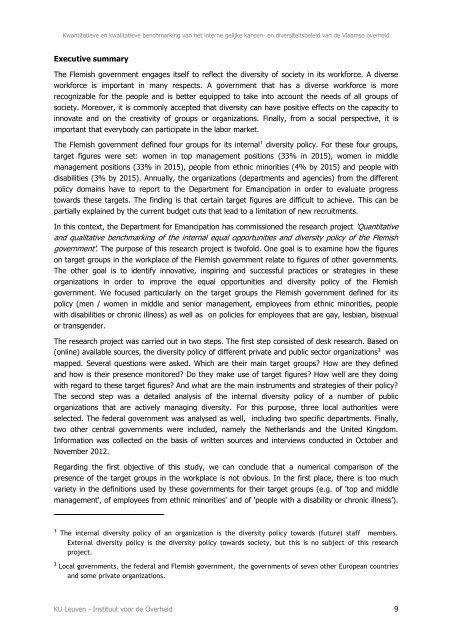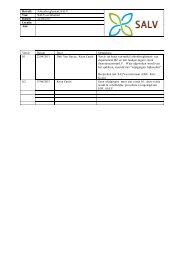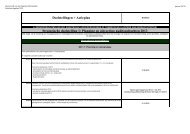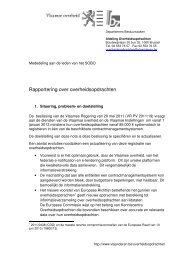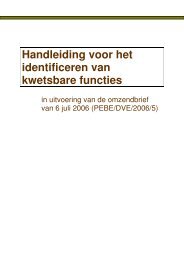Lees hier het rapport van deze kwantitatieve en ... - Bestuurszaken
Lees hier het rapport van deze kwantitatieve en ... - Bestuurszaken
Lees hier het rapport van deze kwantitatieve en ... - Bestuurszaken
Create successful ePaper yourself
Turn your PDF publications into a flip-book with our unique Google optimized e-Paper software.
Kwantitatieve <strong>en</strong> kwalitatieve b<strong>en</strong>chmarking <strong>van</strong> <strong>het</strong> interne gelijke kans<strong>en</strong>- <strong>en</strong> diversiteitsbeleid <strong>van</strong> de Vlaamse overheid<br />
Executive summary<br />
The Flemish governm<strong>en</strong>t <strong>en</strong>gages itself to reflect the diversity of society in its workforce. A diverse<br />
workforce is important in many respects. A governm<strong>en</strong>t that has a diverse workforce is more<br />
recognizable for the people and is better equipped to take into account the needs of all groups of<br />
society. Moreover, it is commonly accepted that diversity can have positive effects on the capacity to<br />
innovate and on the creativity of groups or organizations. Finally, from a social perspective, it is<br />
important that everybody can participate in the labor market.<br />
The Flemish governm<strong>en</strong>t defined four groups for its internal 1 diversity policy. For these four groups,<br />
target figures were set: wom<strong>en</strong> in top managem<strong>en</strong>t positions (33% in 2015), wom<strong>en</strong> in middle<br />
managem<strong>en</strong>t positions (33% in 2015), people from ethnic minorities (4% by 2015) and people with<br />
disabilities (3% by 2015). Annually, the organizations (departm<strong>en</strong>ts and ag<strong>en</strong>cies) from the differ<strong>en</strong>t<br />
policy domains have to report to the Departm<strong>en</strong>t for Emancipation in order to evaluate progress<br />
towards these targets. The finding is that certain target figures are difficult to achieve. This can be<br />
partially explained by the curr<strong>en</strong>t budget cuts that lead to a limitation of new recruitm<strong>en</strong>ts.<br />
In this context, the Departm<strong>en</strong>t for Emancipation has commissioned the research project 'Quantitative<br />
and qualitative b<strong>en</strong>chmarking of the internal equal opportunities and diversity policy of the Flemish<br />
governm<strong>en</strong>t'. The purpose of this research project is twofold. One goal is to examine how the figures<br />
on target groups in the workplace of the Flemish governm<strong>en</strong>t relate to figures of other governm<strong>en</strong>ts.<br />
The other goal is to id<strong>en</strong>tify innovative, inspiring and successful practices or strategies in these<br />
organizations in order to improve the equal opportunities and diversity policy of the Flemish<br />
governm<strong>en</strong>t. We focused particularly on the target groups the Flemish governm<strong>en</strong>t defined for its<br />
policy (m<strong>en</strong> / wom<strong>en</strong> in middle and s<strong>en</strong>ior managem<strong>en</strong>t, employees from ethnic minorities, people<br />
with disabilities or chronic illness) as well as on policies for employees that are gay, lesbian, bisexual<br />
or transg<strong>en</strong>der.<br />
The research project was carried out in two steps. The first step consisted of desk research. Based on<br />
(online) available sources, the diversity policy of differ<strong>en</strong>t private and public sector organizations 2 was<br />
mapped. Several questions were asked. Which are their main target groups? How are they defined<br />
and how is their pres<strong>en</strong>ce monitored? Do they make use of target figures? How well are they doing<br />
with regard to these target figures? And what are the main instrum<strong>en</strong>ts and strategies of their policy?<br />
The second step was a detailed analysis of the internal diversity policy of a number of public<br />
organizations that are actively managing diversity. For this purpose, three local authorities were<br />
selected. The federal governm<strong>en</strong>t was analysed as well, including two specific departm<strong>en</strong>ts. Finally,<br />
two other c<strong>en</strong>tral governm<strong>en</strong>ts were included, namely the Netherlands and the United Kingdom.<br />
Information was collected on the basis of writt<strong>en</strong> sources and interviews conducted in October and<br />
November 2012.<br />
Regarding the first objective of this study, we can conclude that a numerical comparison of the<br />
pres<strong>en</strong>ce of the target groups in the workplace is not obvious. In the first place, there is too much<br />
variety in the definitions used by these governm<strong>en</strong>ts for their target groups (e.g. of 'top and middle<br />
managem<strong>en</strong>t', of employees from ethnic minorities' and of 'people with a disability or chronic illness’).<br />
1 The internal diversity policy of an organization is the diversity policy towards (future) staff members.<br />
External diversity policy is the diversity policy towards society, but this is no subject of this research<br />
project.<br />
2 Local governm<strong>en</strong>ts, the federal and Flemish governm<strong>en</strong>t, the governm<strong>en</strong>ts of sev<strong>en</strong> other European countries<br />
and some private organizations.<br />
KU Leuv<strong>en</strong> - Instituut voor de Overheid 9


